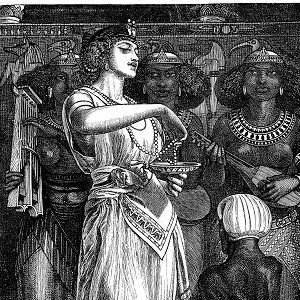Jewelry has been worn by people as far back as historians can find. Jewelry can be a special gift, family heirloom, a fashion accessory, jewelry has played many roles throughout history.

Cleopatra via onthisdayinfashion.com
In ancient times, bracelets and necklaces were made from animal bone and shells and they served as a hunting tool. Many pendants also were transformed into daggers as well.
In Egyptian culture, gold was cherished and also they adorned bodies with gold jewelry and buried them in a gold-plated tomb as they head to the “afterlife.” One of the important pieces of jewelry in Egyptian times was the headdress. Cleopatra is picture often wearing long strings of gold beads and medallions of jewels falling over the shoulders. They also would wrap the deceased as mummies with amulets. Beads were essential to these amulets and anyone could have these with the type they wore dependent on their wealth. They could range from pearls to pottery clay.
For other cultures (Romans, Greeks, Mesopotamians), jewelry played a key role in the upper class. The more adorned a person was, the higher their status. Gold was the most popular followed by silver, bronze, pearls, diamonds, emeralds, sapphires and many others. Greeks wore gold and didn’t use many gemstones. The ladies would often wear seventy-five or more gold necklaces, and earrings. Roman ladies wore many rings and bracelets covering the entire arm.
Jewelry was also worn with the ornaments believed to hold certain powers. It was commonly believed that specific stones could affect the wearer. It was also associated with religion, with gold and jewels being used as gifts of worship.
Jewelry has played three basic roles in the past that are still relevant today. It is seem as the ornament, the amulet and the symbol of wealth.
Sources: History of Jewelry, Seattle Times

Tacoma Jewelry Store
We buy & sell diamond engagement & wedding rings, gold, diamonds & Rolex.